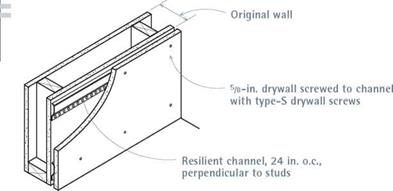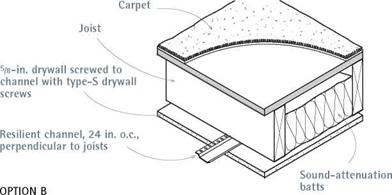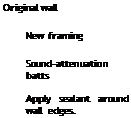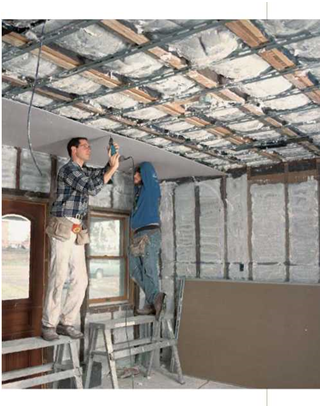Soundproofing
Most noise-related problems can be solved inexpensively, without major architectural remedies. Basically, you can install materials that absorb sound or try to reduce the sound’s transmission by isolating it.
Within a room, use materials that absorb sound. Absorbent materials are often soft, porous, or bulky, such as carpet, cork, cloth drapes, furniture, or a shelf full of books. Conversely, avoid hard, highly finished surfaces that reflect soundwaves.
Fiberglass batts stapled between wall studs and ceiling joists are perhaps the most common means of absorbing sound. Two layers of 58-in. drywall, 358 in. of fiberglass, and the air trapped in the wall will muffle sound effectively. You can also insulate between ceiling joists with fiberglass batts, nail up resilient channels, and then attach 58-in. drywall to the channels with 154-in. type-S drywall screws. Metal resilient channels are commonly used to hang ceilings and even walls. The resilient channel allows the surface to float, so it can move imperceptibly as soundwaves strike it.
A less common option is cellulose and mineral fibers troweled or sprayed onto walls and ceilings, somewhat like an acoustical plaster—the thicker the better. By using a special sprayer, you can apply these compounds up to 3 in. thick. Rigid-foam insulation panels are another option, but because the panels must be carefully fit and caulked to stud and joist bays, most installers opt for friction-fit fiberglass batts instead.
Isolating sound, such as constructing double walls, generally takes more work and expense.
In addition, wherever sound can be transmitted through the building structure, you should add resilient materials.
If you have a central hot-air heating system, fans can be annoying sources of noise, causing vibration along ductwork. In this case, try to





![]()


 |
attach flexible collars (neoprene or canvas) to isolate ductwork vibration. Likewise, if your bedroom is plagued by a noisy fan in a heating system, you can reduce the noise either by remounting or replacing the fan or by packing insulation where the ductwork passes through a wall.
Double walls effectively isolate sound, but they require a lot of material and dramatically reduce room space. To further deaden (and literally cut off) the transmission of sound, say, between floors and walls, you can also cut a kerf through the flooring and subflooring between two walls. The kerf should stop short of the floor joists, however. (^) Note: If either of the double walls contains electrical outlets, turn off the electricity and check with a voltage tester before cutting such a kerf.
Resilient neoprene or foam-rubber pads above the stud-wall top plates and below the sole plates can further deaden sound transmission. Any opening in a wall will allow sound to enter. If you need an extremely quiet room, minimize the number of doors and windows, and weatherstrip them. Installing weatherstripping gaskets around interior doors also cuts sound. Finally, minimize the openings that run through walls, such as ducts, back-to-back electrical outlets, and so on.







Leave a reply